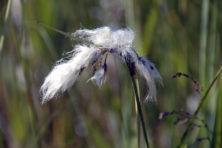Door to Nature: A Fast-Growing Autumn Beauty
- Share
- Tweet
- Pin
- Share

These mid-October days provide so many colors in the natural landscape. One of my favorites is the staghorn sumac. Its green foliage blends in with many trees along roadsides all summer, then in autumn they reach their peak of brilliant color and stand out along the highways.
Staghorn sumac received its name because the velvety, newest growth of branches resembles the early summer antlers of the male white-tailed deer. It is a member of the cashew family, which has about 500 species worldwide, and is one of the fastest growing of all trees.
Some people may think of it as a shrub since many can be rather small. The American Forestry Association says that for a plant to be considered a tree it must be at least 13 feet tall. I have seen many sumacs that are 15 to 20 feet tall.
Large clusters of whitish flowers form in late spring, become pollinated, and then develop the deep, red fruiting structures, called “bobs,” due to their shape as they appear like a plumb bob. This fruit stays on the plant throughout the winter and provides emergency food to robins and eastern bluebirds when they return in spring and endure late season snow storms.
Other wildlife species use this plant for food. White-tailed deer are fond of the fuzzy branches and break off numerous sections as they search for scarce food in winter. Many birds relish the red bobs such as ruffed grouse and the dark-eyed junco. Chipmunks store the soft maroon fruits in their underground quarters while cottontails nibble on tender young twigs.
I’ve heard of people using the fruits to make “pink lemonade.” In case you have never tasted one of the tiny individual fruits on a colorful bob, try it. They are quite tart but perfectly safe to nibble on. Small hairs covering the fleshy pulp (called “drupes”), contain malic acid, identical to that found in unripe apples.
If you decide to make lemonade from the red fruits, be sure not to boil the fruit in water. This releases a certain amount of tannin, which will make the drink taste like medicine. It is best to crush the bobs in cold water, strain it to remove the hairs, sweeten it with maple sugar and drink it.
Whenever a wild plant is discussed as food for people, one may ask, “How can staghorn sumac be distinguished from poison sumac?” Poison sumac grows in swamps and on the wet soggy edges of bogs and lakes. Its leaves do not have teeth on the margins and the fruits consist of loose, drooping clusters of light, yellowish-green berries, much like those on poison ivy.
It’s been said that the poison of poison sumac is more dangerous than its close relative, poison ivy. In fact, both plants are in the same genus, Rhus. We have never found poison sumac in Door County, but Roy did find some at Lily Lake in Brown County years ago.
The genus name of Rhus (roose), is a Celtic word meaning “red,” also a Greek word for “run” in respect to its roots. Staghorn sumacs are quite common throughout this region. Their species name, typhena (ty-FEE-na), comes from typha, the cattail, for its similar velvety branches.
Some say that sumac is from the Arabic word “Simaq,” which is what they call their species. There are as many as 50 kinds that are native to Europe, Asia and eastern North America.
The gnarled gray branches of old sumac trees can provide you with some beautiful wood. Roy learned that you can cut an inch and a half thick stem at a diagonal and, if solid, you can sand and varnish the half-inch-thick piece and turn it into a bolo tie or a necklace. It takes on an appearance like a tan, African tiger-eye stone.
One road in northern Door County is spelled Summach Road. Perhaps that’s due to the German settlers who farmed the area 100 years ago. A favorite tale I heard is of an intelligent Englishman approaching George Bernard Shaw, the literary giant, and said, “Mr. Shaw, do you realize that in the English language there are only two words beginning with the letters ‘su’ that receive the ‘sh’ sound – sugar and sumac?
To which Mr. Shaw replied, “Sure!”
Yes, we have occasionally heard people pronounce the word “sumac” as though it was spelled “shumac.”
Few other trees in North America can match the staghorn sumac for overall interest and beauty of form and color, and for providing wildlife with food at a time when it is very challenging to obtain. I “shure” like sumac!



